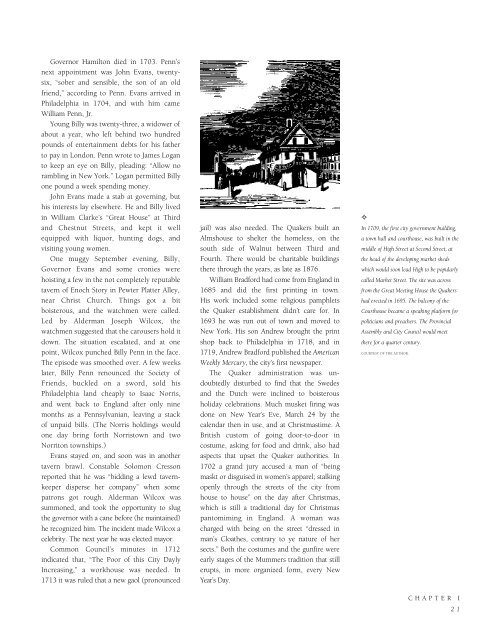Historic Philadelphia
An illustrated history of the city of Philadelphia, paired with the histories of companies, families and organizations that make the region great.
An illustrated history of the city of Philadelphia, paired with the histories of companies, families and organizations that make the region great.
Create successful ePaper yourself
Turn your PDF publications into a flip-book with our unique Google optimized e-Paper software.
Governor Hamilton died in 1703. Penn’s<br />
next appointment was John Evans, twentysix,<br />
“sober and sensible, the son of an old<br />
friend,” according to Penn. Evans arrived in<br />
<strong>Philadelphia</strong> in 1704, and with him came<br />
William Penn, Jr.<br />
Young Billy was twenty-three, a widower of<br />
about a year, who left behind two hundred<br />
pounds of entertainment debts for his father<br />
to pay in London. Penn wrote to James Logan<br />
to keep an eye on Billy, pleading: “Allow no<br />
rambling in New York.” Logan permitted Billy<br />
one pound a week spending money.<br />
John Evans made a stab at governing, but<br />
his interests lay elsewhere. He and Billy lived<br />
in William Clarke’s “Great House” at Third<br />
and Chestnut Streets, and kept it well<br />
equipped with liquor, hunting dogs, and<br />
visiting young women.<br />
One muggy September evening, Billy,<br />
Governor Evans and some cronies were<br />
hoisting a few in the not completely reputable<br />
tavern of Enoch Story in Pewter Platter Alley,<br />
near Christ Church. Things got a bit<br />
boisterous, and the watchmen were called.<br />
Led by Alderman Joseph Wilcox, the<br />
watchmen suggested that the carousers hold it<br />
down. The situation escalated, and at one<br />
point, Wilcox punched Billy Penn in the face.<br />
The episode was smoothed over. A few weeks<br />
later, Billy Penn renounced the Society of<br />
Friends, buckled on a sword, sold his<br />
<strong>Philadelphia</strong> land cheaply to Isaac Norris,<br />
and went back to England after only nine<br />
months as a Pennsylvanian, leaving a stack<br />
of unpaid bills. (The Norris holdings would<br />
one day bring forth Norristown and two<br />
Norriton townships.)<br />
Evans stayed on, and soon was in another<br />
tavern brawl. Constable Solomon Cresson<br />
reported that he was “bidding a lewd tavernkeeper<br />
disperse her company” when some<br />
patrons got rough. Alderman Wilcox was<br />
summoned, and took the opportunity to slug<br />
the governor with a cane before (he maintained)<br />
he recognized him. The incident made Wilcox a<br />
celebrity. The next year he was elected mayor.<br />
Common Council’s minutes in 1712<br />
indicated that, “The Poor of this City Dayly<br />
Increasing,” a workhouse was needed. In<br />
1713 it was ruled that a new gaol (pronounced<br />
jail) was also needed. The Quakers built an<br />
Almshouse to shelter the homeless, on the<br />
south side of Walnut between Third and<br />
Fourth. There would be charitable buildings<br />
there through the years, as late as 1876.<br />
William Bradford had come from England in<br />
1685 and did the first printing in town.<br />
His work included some religious pamphlets<br />
the Quaker establishment didn’t care for. In<br />
1693 he was run out of town and moved to<br />
New York. His son Andrew brought the print<br />
shop back to <strong>Philadelphia</strong> in 1718, and in<br />
1719, Andrew Bradford published the American<br />
Weekly Mercury, the city’s first newspaper.<br />
The Quaker administration was undoubtedly<br />
disturbed to find that the Swedes<br />
and the Dutch were inclined to boisterous<br />
holiday celebrations. Much musket firing was<br />
done on New Year’s Eve, March 24 by the<br />
calendar then in use, and at Christmastime. A<br />
British custom of going door-to-door in<br />
costume, asking for food and drink, also had<br />
aspects that upset the Quaker authorities. In<br />
1702 a grand jury accused a man of “being<br />
maskt or disguised in women’s apparel; stalking<br />
openly through the streets of the city from<br />
house to house” on the day after Christmas,<br />
which is still a traditional day for Christmas<br />
pantomiming in England. A woman was<br />
charged with being on the street “dressed in<br />
man’s Cloathes, contrary to ye nature of her<br />
sects.” Both the costumes and the gunfire were<br />
early stages of the Mummers tradition that still<br />
erupts, in more organized form, every New<br />
Year’s Day.<br />
✧<br />
In 1709, the first city government building,<br />
a town hall and courthouse, was built in the<br />
middle of High Street at Second Street, at<br />
the head of the developing market sheds<br />
which would soon lead High to be popularly<br />
called Market Street. The site was across<br />
from the Great Meeting House the Quakers<br />
had erected in 1695. The balcony of the<br />
Courthouse became a speaking platform for<br />
politicians and preachers. The Provincial<br />
Assembly and City Council would meet<br />
there for a quarter century.<br />
COURTESY OF THE AUTHOR.<br />
CHAPTER I<br />
21
















